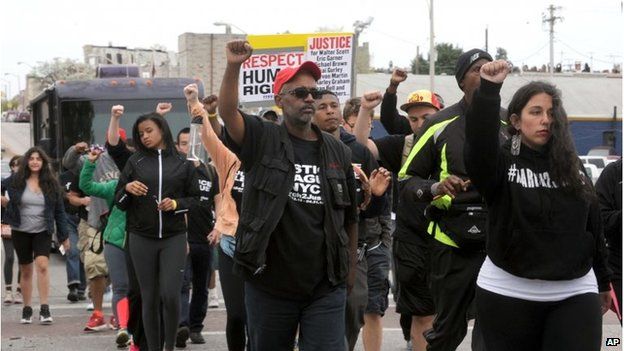Freddie Gray's death in police custody - what we know
- Published

A police officer has been acquitted in relation to the death of 25-year-old Freddie Gray, who died in hospital from spinal injuries a week after police took him into custody. But what happened the day of his arrest in Baltimore?
THE ARREST
Mobile phone video from a bystander shows Gray's arrest on 12 April around 08:40 local time (13:40 BST), on Presbury Street in the Sandtown neighbourhood of the city.
Two men in yellow uniforms with "Baltimore Police" labels are seen pinning the black man to the ground.
A court document says that Gray had "fled unprovoked upon noticing police presence". It also said that Gray "was arrested without force or incident".
But state prosecutor Marilyn Mosby said that Gray was illegally arrested, assaulted and falsely accused of carrying an illegal switchblade.
An officer said that he had found it clipped inside Gray's trouser pocket after he had been detained.
Ms Mosby said that it was actually a legal knife and therefore did not justify arrest.
Police Commissioner Anthony Batts has also stated that it is not clear why Gray was stopped by the officers as there "is no law against running".
Billy Murphy, a lawyer hired by the Gray family agrees. "Running while black is not probable cause," he said.
THE POLICE VAN
In the mobile phone video, Gray can be heard screaming repeatedly before a police van arrives to take him away.
Ms Mosby said his arms had been handcuffed behind his back and that his requests for his inhaler had been ignored.
Police officers had also put him into a tactical hold before putting him in the back of the van, she said.
Police officials have said that Gray should have received medical attention before he was put inside the van.
While the van was en route to the police station, officers put Gray in leg irons after an officer determined that he became "irate".
Ms Mosby has said that the officers had then loaded him "on his stomach head first into the wagon."
Gray was not restrained with a seat belt, which is a violation of police department policy.
The officers later failed to get medical help even though Gray requested it repeatedly, Ms Mosby said.
The officers then stopped to pick up another suspect in a separate case while on the way to the police station.
Ms Mosby called the stop "grossly negligent". She said that Gray had asked for medical help and complained of trouble breathing.
Police timeline of the arrest
- Sunday, 12 April, 0839: Officers approach Gray and he flees on foot
- 0840: Gray arrested on corner of Presbury Street, Sandtown
- 0842: Police request a van
- 0854: Van departs with Gray inside, conscious and speaking
- 0854-0924: Van makes a total of four stops between arrest and police station arrival
- 0924: Police request paramedics to take Gray to hospital
THE INJURIES
Officer Miller's document says that Gray "suffered a medical emergency" while he was being transported and that he was "immediately transported to Shock Trauma via medic".
He arrived in a critical condition.
Briefing the media on the results of an autopsy on Monday, Deputy Commissioner Jerry Rodriguez said Gray "did suffer a very tragic injury to his spinal cord which resulted in his death".
Mr Murphy said that Gray's "spine was 80% severed at his neck".
The other suspect in the van was on another side of a metal barrier preventing him from seeing or making contact with Gray, Mr Rodriguez said.
"I know that when Mr Gray was placed inside that van, he was able to talk, he was upset," Mr Rodriguez said. "And when Mr Gray was taken out of that van he could not talk and he could not breathe."
Gray's family told the Baltimore Sun newspaper that doctors at a local hospital performed surgeries to treat three broken vertebrae and an injured voice box. He was comatose until his death on Sunday.
The paper reported on Tuesday that "significant force" would be required to inflict those injuries. It said, citing medical experts, that the force would be similar to that of "the impact from a car accident".
THE FALLOUT
Demonstrators have taken to the streets to protest against excessive use of force. In early days, most of the protests were calm. Many carried banners, some of which read "Black lives matter" - an echo of similar protests around the country in recent months.
But a week after Gray died, and with police releasing little new information about the circumstances of his death, the demonstrations took a violent turn.
On 27 April, a funeral service for Gray was held. That afternoon and evening rioters tore through parts of Baltimore leaving a path of debris, burnt or smashed cars, and looted storefronts.
The National Guard was dispatched in an attempt to restore control and the mayor ordered a curfew between the hours of 2200 and 0500.
On 1 May the state prosecutor announced criminal charges against six police officers involved in the case.
The first trial's jury could not reach a verdict and the second officer on trial was acquitted.